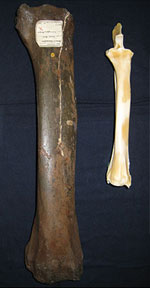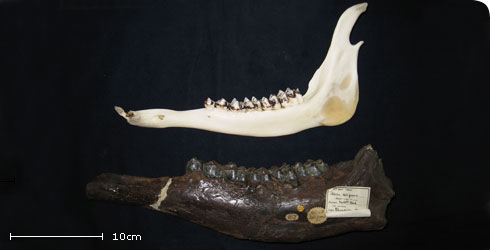Biology

Right radius (forearm bone) of Cervalces latifrons from Trimingham (Forest Bed Formation, Norfolk) with the same bone of a recent red deer specimen for size comparison
Living moose (Alces alces) is a typical browser, feeding on:
- tender bark
- leaves
- green shoots of trees and shrubs (willow, aspen, pine, mountain ash, birch, larch, oak)
- telmatic vegetation
- high forbs
Cervalces shares many cranio-dental features with Alces which testify to the high specialisation for an analogous strict browsing diet:
- high premolar/molar length ratio with pronounced molarisation of the lower premolars
- low crowned molars with lingual and labial walls converging to the occlusal surface
- enlarged oral cavity through elongation of the muzzle
- very pointed tip of the premaxillary bones, allowing selection of the more palatable twigs and leaves
- shallow body of the mandible
The large size of living moose and its long legs are an adaptation to a fast trot over obstacles. This gait, named ‘stilt-locomotion’, is performed by a long stride and a high elevation of the metapodials, and is ideal for moving on deep snow and boggy areas strewn with debris, shrubs, and tall herbs.
Like Alces, Cervalces latifrons had long legs and shared many of the limb bone adaptations involved in ‘stilt-locomotion’ that are not found in other deer, including:
- elongation of humerus and radius in comparison with distal segments, resulting in increased power at the foot, rather than increased speed and related to the frequency with which moose swim and move on swampy ground
- the peculiar morphology of the femur head, which is spherical, rather than cylindrical and ensures more lateral movement of the proximal segment of the leg, consistent with stilt-locomotion in which the uplifted distal leg remains more rigid
- the greater fusion of the ankle bones (in comparison to the general pattern found in ruminants), with the cuneiforms sometimes joined to the navico-cuboid, again consistent with stilt-locomotion
- the long phalanges and the peculiar morphology of the articular facet of the ungueal phalanx, which allow wide spreading of the toes - an adaptation to prevent sinking in soft ground and to swimming
Toolbox
Glossary
Articular facet of the ungueal phalanx
Portion of the phalanx bearing the nails/claws which articulates to the previous finger/toe bones.
Chronospecies
A group of organisms that is derived from its ancestor (and/or develops into its descendant) by a process of slow, steady, evolutionary change and is not regarded as a member of the same species as its ancestor and/or descendant.
Cuneiforms
Bones of the ankle.
Ethology
Scientific study of animal behaviour.
Forbs
Herbaceous flowering plants that are not graminoids (grasses, sedges and rushes). The term is used in vegetation ecology to represent a guild of grassland plant species with broadly similar growth form, which in ecology is often more important than taxonomic relationship.
Holotype
The single specimen designated by an author to formally describe a new species.
Navico-cuboid
Main bone of the ankle of Ruminant animals.
Non-gregarious
Non-social, solitary
Metapodials
Hand and foot bones between the fingers/toes and the wrist/ankle.
Palustrine
Living in a marsh or swamp.
Phalanges
Bones of the fingers and toes.
Phyletic lineage
Ancestor-descendent populations that undergo morphological change over time.
Telmatic vegetation
Vegetation living in the swamp zone of a lake developing into a bog.
